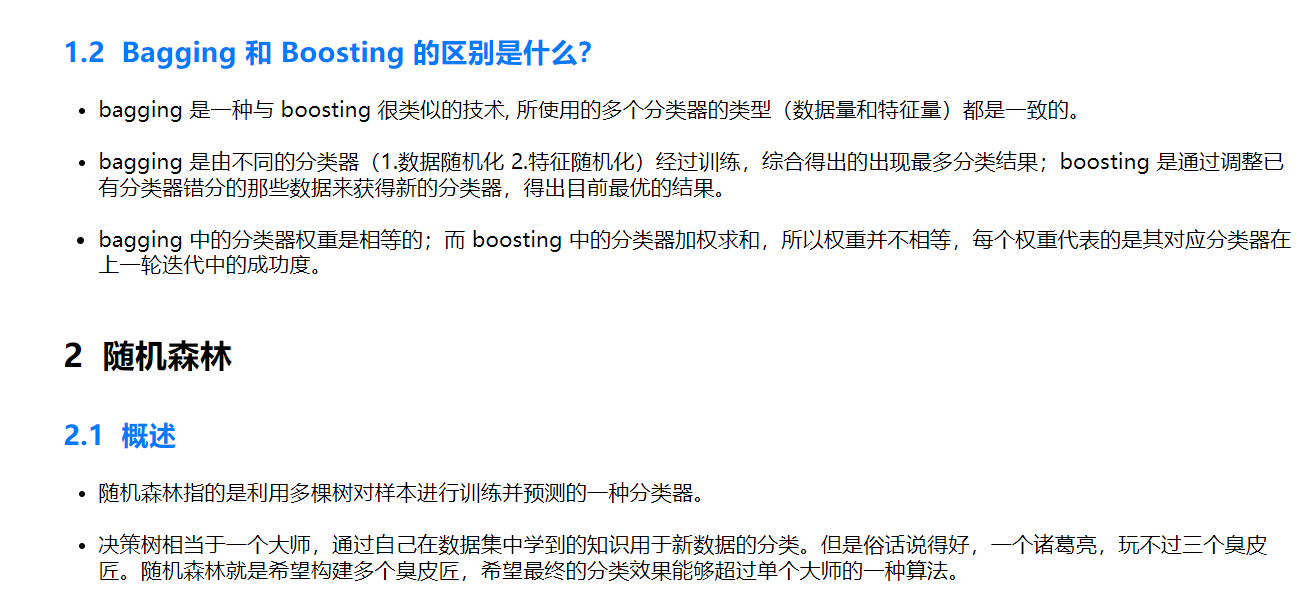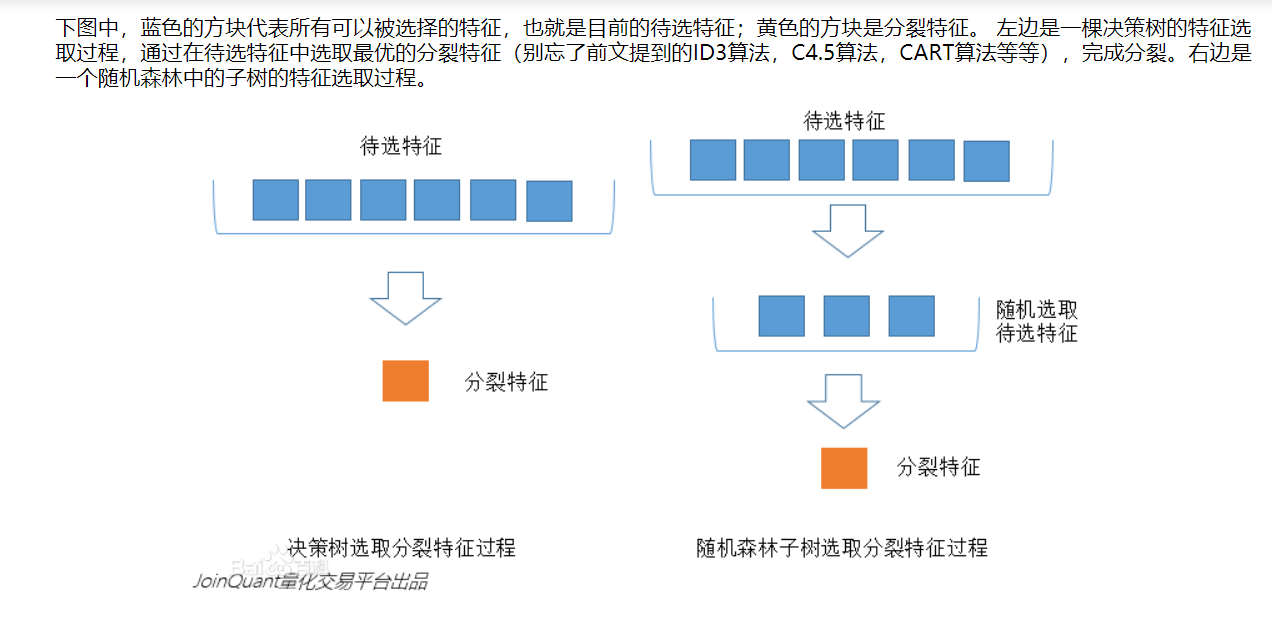随机森林 python实现





from random import seed,randrange,random
from sklearn.model_selection import train_test_split
import numpy as np
# 导入csv文件
def loadDataSet(filename):
dataset = []
with open(filename, 'r') as fr:
for line in fr.readlines():
if not line:
continue
lineArr = []
for featrue in line.split(','):
# strip()返回移除字符串头尾指定的字符生成的新字符串
str_f = featrue.strip()
# isdigit 如果是浮点型数值,就是 false,所以换成 isalpha() 函数
# if str_f.isdigit(): # 判断是否是数字
if str_f.isalpha(): # 如果是字母,说明是标签
# 添加分类标签
lineArr.append(str_f)
else:
# 将数据集的第column列转换成float形式
lineArr.append(float(str_f))
dataset.append(lineArr)
return dataset
def cross_validation_split(dataset, n_folds):
"""cross_validation_split(将数据集进行抽重抽样 n_folds 份,数据可以重复重复抽取,每一次list的元素是无重复的)
Args:
dataset 原始数据集
n_folds 数据集dataset分成n_flods份
Returns:
dataset_split list集合,存放的是:将数据集进行抽重抽样 n_folds 份,数据可以重复重复抽取,每一次list的元素是无重复的
"""
dataset_split = list()
dataset_copy = list(dataset) # 复制一份 dataset,防止 dataset 的内容改变
fold_size = len(dataset) / n_folds
for i in range(n_folds):
fold = list() # 每次循环 fold 清零,防止重复导入 dataset_split
while len(fold) < fold_size: # 这里不能用 if,if 只是在第一次判断时起作用,while 执行循环,直到条件不成立
# 有放回的随机采样,有一些样本被重复采样,从而在训练集中多次出现,有的则从未在训练集中出现,此则自助采样法。从而保证每棵决策树训练集的差异性
index = randrange(len(dataset_copy))
# 将对应索引 index 的内容从 dataset_copy 中导出,并将该内容从 dataset_copy 中删除。
# pop() 函数用于移除列表中的一个元素(默认最后一个元素),并且返回该元素的值。
# fold.append(dataset_copy.pop(index)) # 无放回的方式
fold.append(dataset_copy[index]) # 有放回的方式
dataset_split.append(fold)
# 由dataset分割出的n_folds个数据构成的列表,为了用于交叉验证
return dataset_split
# Split a dataset based on an attribute and an attribute value # 根据特征和特征值分割数据集
def test_split(index, value, dataset):
left, right = list(), list()
for row in dataset:
if row[index] < value:
left.append(row)
else:
right.append(row)
return left, right
def gini_index(groups, class_values): # 个人理解:计算代价,分类越准确,则 gini 越小
gini = 0.0
D = len(groups[0]) + len(groups[1])
for class_value in class_values: # class_values = [0, 1]
for group in groups: # groups = (left, right)
size = len(group)
if size == 0:
continue
proportion = [row[-1] for row in group].count(class_value) / float(size)
gini += float(size)/D * (proportion * (1.0 - proportion)) # 个人理解:计算代价,分类越准确,则 gini 越小
return gini
# 找出分割数据集的最优特征,得到最优的特征 index,特征值 row[index],以及分割完的数据 groups(left, right)
def get_split(dataset, n_features):
class_values = list(set(row[-1] for row in dataset)) # class_values =[0, 1]
b_index, b_value, b_score, b_groups = 999, 999, 999, None
features = list()
while len(features) < n_features:
index = randrange(len(dataset[0])-1) # 往 features 添加 n_features 个特征( n_feature 等于特征数的根号),特征索引从 dataset 中随机取
if index not in features:
features.append(index)
for index in features: # 在 n_features 个特征中选出最优的特征索引,并没有遍历所有特征,从而保证了每课决策树的差异性
for row in dataset:
groups = test_split(index, row[index], dataset) # groups=(left, right), row[index] 遍历每一行 index 索引下的特征值作为分类值 value, 找出最优的分类特征和特征值
gini = gini_index(groups, class_values)
# 左右两边的数量越一样,说明数据区分度不高,gini系数越大
if gini < b_score:
b_index, b_value, b_score, b_groups = index, row[index], gini, groups # 最后得到最优的分类特征 b_index,分类特征值 b_value,分类结果 b_groups。b_value 为分错的代价成本
# print b_score
return {'index': b_index, 'value': b_value, 'groups': b_groups}
# Create a terminal node value # 输出group中出现次数较多的标签
def to_terminal(group):
outcomes = [row[-1] for row in group] # max() 函数中,当 key 参数不为空时,就以 key 的函数对象为判断的标准
return max(set(outcomes), key=outcomes.count) # 输出 group 中出现次数较多的标签
# Create child splits for a node or make terminal # 创建子分割器,递归分类,直到分类结束
def split(node, max_depth, min_size, n_features, depth): # max_depth = 10, min_size = 1, n_features=int(sqrt((len(dataset[0])-1)
left, right = node['groups']
del(node['groups'])
# check for a no split 类别完全相同,不用划分了,直接返回类别中最多的那个类
if not left or not right:
node['left'] = node['right'] = to_terminal(left + right)
return
# check for max depth
if depth >= max_depth: # max_depth=10 表示递归十次,若分类还未结束,则选取数据中分类标签较多的作为结果,使分类提前结束,防止过拟合
node['left'], node['right'] = to_terminal(left), to_terminal(right)
return
# process left child
if len(left) <= min_size:
node['left'] = to_terminal(left)
else:
node['left'] = get_split(left, n_features) # node['left']是一个字典,形式为{'index':b_index, 'value':b_value, 'groups':b_groups},所以node是一个多层字典
split(node['left'], max_depth, min_size, n_features, depth+1) # 递归,depth+1计算递归层数
# process right child
if len(right) <= min_size:
node['right'] = to_terminal(right)
else:
node['right'] = get_split(right, n_features)
split(node['right'], max_depth, min_size, n_features, depth+1)
# Build a decision tree
def build_tree(train, max_depth, min_size, n_features):
"""build_tree(创建一个决策树)
Args:
train 训练数据集
max_depth 决策树深度不能太深,不然容易导致过拟合
min_size 叶子节点的大小
n_features 选取的特征的个数
Returns:
root 返回决策树
"""
# 返回最优列和相关的信息
root = get_split(train, n_features)
# 对左右2边的数据 进行递归的调用,由于最优特征使用过,所以在后面进行使用的时候,就没有意义了
# 例如: 性别-男女,对男使用这一特征就没任何意义了
split(root, max_depth, min_size, n_features, 1)
return root
# Make a prediction with a decision tree
def predict(node, row): # 预测模型分类结果
if row[node['index']] < node['value']:
if isinstance(node['left'], dict): # isinstance 是 Python 中的一个内建函数。是用来判断一个对象是否是一个已知的类型。
return predict(node['left'], row)
else:
return node['left']
else:
if isinstance(node['right'], dict):
return predict(node['right'], row)
else:
return node['right']
# Make a prediction with a list of bagged trees
def bagging_predict(trees, row):
"""bagging_predict(bagging预测)
Args:
trees 决策树的集合
row 测试数据集的每一行数据
Returns:
返回随机森林中,决策树结果出现次数做大的
"""
# 使用多个决策树trees对测试集test的第row行进行预测,再使用简单投票法判断出该行所属分类
predictions = [predict(tree, row) for tree in trees]
return max(set(predictions), key=predictions.count)
# Create a random subsample from the dataset with replacement
def subsample(dataset, ratio): # 创建数据集的随机子样本
"""random_forest(评估算法性能,返回模型得分)
Args:
dataset 训练数据集
ratio 训练数据集的样本比例
Returns:
sample 随机抽样的训练样本
"""
sample = list()
# 训练样本的按比例抽样。
# round() 方法返回浮点数x的四舍五入值。
n_sample = round(len(dataset) * ratio)
while len(sample) < n_sample:
# 有放回的随机采样,有一些样本被重复采样,从而在训练集中多次出现,有的则从未在训练集中出现,此则自助采样法。从而保证每棵决策树训练集的差异性
index = randrange(len(dataset))
sample.append(dataset[index])
return sample
# Random Forest Algorithm
def random_forest(train, test, max_depth, min_size, sample_size, n_trees, n_features):
"""random_forest(评估算法性能,返回模型得分)
Args:
train 训练数据集
test 测试数据集
max_depth 决策树深度不能太深,不然容易导致过拟合
min_size 叶子节点的大小
sample_size 训练数据集的样本比例
n_trees 决策树的个数
n_features 选取的特征的个数
Returns:
predictions 每一行的预测结果,bagging 预测最后的分类结果
"""
trees = list()
# n_trees 表示决策树的数量
for i in range(n_trees):
# 随机抽样的训练样本, 随机采样保证了每棵决策树训练集的差异性
sample = subsample(train, sample_size)
# 创建一个决策树
tree = build_tree(sample, max_depth, min_size, n_features)
trees.append(tree)
# 每一行的预测结果,bagging 预测最后的分类结果
predictions = [bagging_predict(trees, row) for row in test]
return predictions
# Calculate accuracy percentage
def accuracy_metric(actual, predicted): # 导入实际值和预测值,计算精确度
correct = 0
for i in range(len(actual)):
if actual[i] == predicted[i]:
correct += 1
return correct / float(len(actual)) * 100.0
# 评估算法性能,返回模型得分
def evaluate_algorithm(dataset, algorithm, n_folds, *args):
"""evaluate_algorithm(评估算法性能,返回模型得分)
Args:
dataset 原始数据集
algorithm 使用的算法
n_folds 数据的份数
*args 其他的参数
Returns:
scores 模型得分
"""
# 将数据集进行抽重抽样 n_folds 份,数据可以重复重复抽取,每一次 list 的元素是无重复的
folds = cross_validation_split(dataset, n_folds)
scores = list()
# 每次循环从 folds 从取出一个 fold 作为测试集,其余作为训练集,遍历整个 folds ,实现交叉验证
for fold in folds:
train_set = list(folds)
train_set.remove(fold)
train_set = sum(train_set, [])
test_set = list()
# fold 表示从原始数据集 dataset 提取出来的测试集
for row in fold:
row_copy = list(row)
row_copy[-1] = None
test_set.append(row_copy)
predicted = algorithm(train_set, test_set, *args)
actual = [row[-1] for row in fold]
# 计算随机森林的预测结果的正确率
accuracy = accuracy_metric(actual, predicted)
scores.append(accuracy)
return scores
if __name__ == '__main__':
# 加载数据
dataset = loadDataSet('./data/sonar_data.txt')
# print dataset
n_folds = 5 # 分成5份数据,进行交叉验证
max_depth = 20 # 调参(自己修改) #决策树深度不能太深,不然容易导致过拟合
min_size = 1 # 决策树的叶子节点最少的元素数量
sample_size = 1.0 # 做决策树时候的样本的比例
# n_features = int((len(dataset[0])-1))
n_features = 15 # 调参(自己修改) #准确性与多样性之间的权衡
for n_trees in [1,10]: # 理论上树是越多越好
scores = evaluate_algorithm(dataset, random_forest, n_folds, max_depth, min_size, sample_size, n_trees, n_features)
# 每一次执行本文件时都能产生同一个随机数
seed(1)
print('random=', random())
print('Trees: %d' % n_trees)
print('Scores: %s' % scores)
print('Mean Accuracy: %.3f%%' % (sum(scores)/float(len(scores))))
运行结果:
random= 0.13436424411240122 Trees: 1 Scores: [90.47619047619048, 80.95238095238095, 69.04761904761905, 92.85714285714286, 61.904761904761905] Mean Accuracy: 79.048% random= 0.13436424411240122 Trees: 10 Scores: [90.47619047619048, 78.57142857142857, 83.33333333333334, 90.47619047619048, 85.71428571428571] Mean Accuracy: 85.714%




 浙公网安备 33010602011771号
浙公网安备 33010602011771号